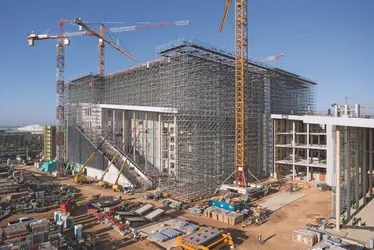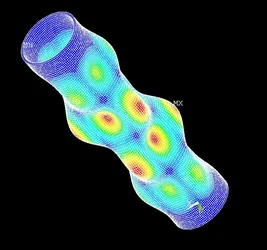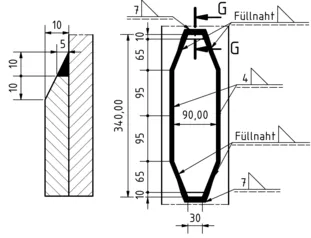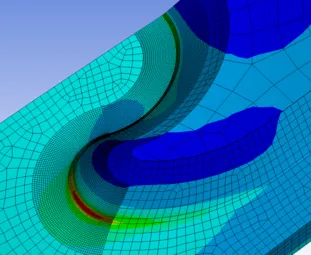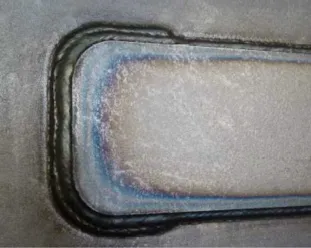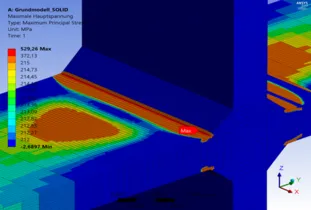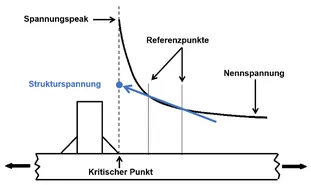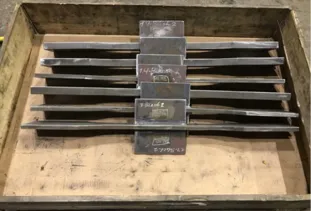Overview
Ongoing research projects:
Completed research projects:
- AiF IGF 20800 N - Shape optimization of welded-on cover plates under fatigue loading
- AiF FOSTA P 1271/28/2018 - Use of the structural stress concept at fatigue loaded steel structures
- AIF FOSTA P 1033 - Ermüdungsnachweis von Schienen auf Basis bruchmechanischer Kriterien
- AIF 14771 N1 - Entwicklung und Aufbereitung wirtschaftlicher Bemessungsregeln für Stahl- und Verbundträger mit schlanken Stegblechen im Hoch- und Brückenbau
- AIF 16872 N - Ermittlung von Drehfedersteifigkeiten von Stahlbauanschlüssen zur Bestimmung des idealen Biegedrillknickmomentes
High-strength tubes in scaffolding and crane construction
- AiF-FOSTA research project (IGF project no.: 21439 N/1;application no.: 03157/20)
- Project period: 10/2020 - 03/2023
- Project partners: FOSTA, PERI GmbH Schalung Gerüst Engineering, Kerscher Gerüstbau, Schäfer Gerüstbau GmbH, Wuppermann Austria GmbH, Garske und Partner GmbH, Hertle Ingenieure and other industrial partners
In crane and scaffolding construction, mainly cold finished, hot-dip galvanized tubes with D= 48.3 mm made of S355 are used. According to DIN EN 12810-1, a minimum nominal wall thickness of t= 2.7 mm must be maintained for the above-mentioned diameter in order to prevent the tube from being pressed in by the contact pressure if the coupling is tightened too much. In the case of shoring towers, increasingly larger diameters of D> 60 mm are becoming common. The use of high-strength steels with steel grades up to S960 seems to offer promising material savings. In addition to the global stability behavior, local buckling failure plays a decisive role in dimensioning due to lower wall thicknesses.
The aim of the research project is therefore to develop the basic principles necessary for the use of high-strength, thin-walled and raw or hot-dip galvanized tubes as compression members in crane and scaffolding construction. The research is mainly carried out experimentally, on the basis of which the numerical models are verified and calibrated. Specifically, permissible D/t ratios for high-strength pipe supports are to be worked out to avoid local buckling. For design purposes, a buckling stress line will be established for thin-walled, cold-formed and raw or hot-dip galvanized pipes made of high-strength steel in the diameter range from D= 48.3 mm to approx. D= 80 mm. Furthermore, a minimum wall thickness for high-strength tubes with D = 48.3 mm is specified when using standard scaffold couplings or standard connections in crane construction. Finally, the robustness and impact resistance of the high-strength pipe supports is investigated and their mechanical properties and metallurgical conditions are checked in order to quantify the influences of cold forming, welding and final galvanizing.
It is expected that the use of high-strength steels will lead to a weight reduction of approx. 25% in crane and scaffolding construction. There are advantages in terms of economic efficiency, health protection of employees, but also in terms of climate protection and resource efficiency.
Responsibility
Drilon Gubetini
Shape optimization of welded-on cover plates under fatigue loading
- AiF-FOSTA research project (IGF-project no.: 20800 N; application no.: N03108/19)
- Project period: 12/2019 - 11/2022
- Project partners: FOSTA, University of Applied Sciences Munich, Maurer Engineering GmbH, Zwickauer Sonderstahlbau GmbH, Stahlbau Wegscheid GmbH, Haslinger GmbH and further partners from industry
Welded-on cover plates have always been a standard design for steel constructions. Cover plate constructions are used for weight optimization and as local reinforcement measures. Typical areas of application are bridge structures, crane constructions, as well as commercial and industrial vehicle engineering. To reduce the total plate thickness of girders, cover plates are arranged as flange reinforcement to be able to bear varying bending moments. This allows lighter and more economical designs. In addition to weight and production optimization, the advantages of easily producible high-strength steels can be utilized. Furthermore, welded-on cover plates can be used as reinforcement for high local additional loads as for load introduction areas in bridges.
The above mentioned typical applications of welded-on cover plates are often subject to cyclic loads and must therefore be designed against fatigue of the material. For example, road and railway bridge construction are subject to high cyclical loads due to traffic. Material fatigue is therefore one of the fundamental causes of damage. The fatigue strength is significantly influenced by the geometry-dependent stress concentrations at welded detail points. Due to the high local notch intensity is the notch detail at the end of the cover plate the most critical point of the reinforcing plate construction and therefore often the most critical notch detail of the entire construction. Therefore, the advantages of higher and high-strength steel grades often cannot be fully utilized. Optimization of the notch detail of the end of the cover plates in terms of fatigue strength is consequently a decisive measure to be able to realize lightweight and economical steel structures.
The objective of the research project is to develop a user-oriented verification concept to enable the planning, design, execution and quality assurance of optimized cover plate structures for practical applications. For this purpose, existing test results are evaluated and numerical as well as experimental preliminary investigations for shape optimization are conducted, which will also be extended to large structures in the further course of the research project. Furthermore, the installation situation of the welded-on cover plates plays a decisive role and also will be investigated. In addition, fatigue tests are performed on test specimens with post-treated welds. Ultimately, computational SN-curves and a user-friendly verification concept are to be developed for reference structures for optimized cover plate run-out geometries.
Responsibility
Niclas Rausch
Use of the structural stress concept at fatigue loaded steel structures
- AiF-FOSTA research project (FOSTA project no.: P 1271/28/2018)
- Project period: 11/2018 - 04/2021
- Project partners: FOSTA, SEH, IB Lutzens, Maurer, IBUKO, Hertle Ingenieure and further partners from industry
In general, fatigue analyses of steel structures are performed as stress analyses in the component and weld according to the nominal stress concept specified in DIN EN 1993-1-9. In finite element calculations, however, this concept can only be applied to a limited extent, since local stress increases at the notch cannot be determined.
The structural stress concept is therefore a more accurate method for fatigue verifications and is in many areas already part of the standard engineering practice. However, their application in civil engineering has not been sufficiently regulated to date. There is a lack of guidelines for the modeling, for the determination of stresses and for approaches to deal with misalignment and thickness influences. Due to the insufficient regulations, incorrect applications frequently result in practice, leading to considerable planning uncertainty.
Consequently, it is important to investigate the structural stress concept as a normatively based method for fatigue safety, and to create conclusive regulations. Therefore, numerical investigations on several details are performed within the scope of this research project. In addition, factors for the structural stress concept will be evaluated by means of suitable FE analyses. Based on static tests, stress concentration factors are determined. In addition to existing test results from the literature the results are used to verify the numerical calculations. In order to be able to evaluate the influence of misalignment and plate thickness more precisely, fatigue tests are carried out on ideal and imperfect cruciform joints. To ensure the safe application of the structural stress concept, generally applicable rules for modeling are established. This will provide users with the necessary information and reference models to calibrate independent FE calculations. Finally, the results will be implemented in an updated version of DIN EN 1993-1-9 or in a corresponding DASt guideline.
Responsibility
Niclas Rausch
